| |
|
|
|
US ARMY RUSSET LEATHER .38
CALIBER DOUBLE-ACTION ARMY REVOLVER HOLSTERS – EXCELLENT
EARLY PRODUCTION SPECIMENS:
A
nice offering of four early 20TH Century US
Army Third, Fourth and Fifth Type .38 Caliber Double Action
Revolver Holsters as described in US Military
Holsters and Pistol Cartridge Boxes, Meadows, pages
160-165, and in his subsequent US Military Holsters
and Related Accoutrements on pages 174-179.
Produced to carry any of the .38 Caliber Double Action
Pistols in service at the time, this holster, in black
leather, had seen extensive service during the Spanish
American War, and the arsenals continued to produce them
when the army switched to fair or russet leather in
1902.
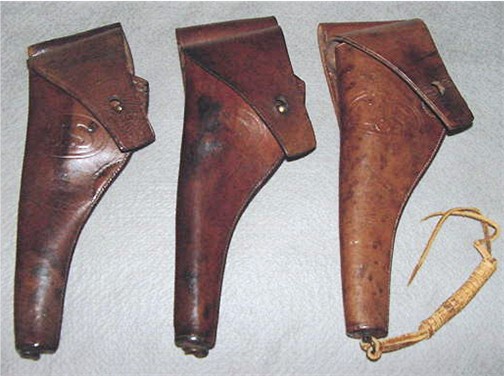
These four holsters, as they present together, make for
a very nice research grouping which tell much of the
story of the early post-1902 production of these
holsters. They incorporate many of the features which
were added to the basic pattern and were considered
necessary enough to apply as a retrofit to holsters
produced in previous years. A good example is the
presence of the leg tie down thong ring mounted in the
plug of all four of these holsters, even though it
wasn’t adopted until 1904.
The holsters offered below as No. 2, No. 3, and No. 4
feature the larger belt loop which was introduced in
1904 to allow the holster to slide over the cartridge
pockets on the Model 1903 Mills Pocketed Pistol
Cartridge Belt, even though one holster was produced in
1903 and another in 1904. Again, an example of how
the arsenal continued to apply the newer features to
previously manufactured holsters.
These holsters are far from common, especially that one
listed as “No. 1” which is quite rare, and when found
often show heavy use in service and the leather is
heavily oil soaked. These four specimens are in
excellent condition with very legible arsenal and
inspector stamps, and would be very difficult to
upgrade.
I have been fortunate enough to acquire the specimens
offered below, and each is described separately with
accompanying photographs.
|
|
NO. 1
US ARMY RUSSET LEATHER .38 CALIBER
DOUBLE-ACTION ARMY REVOLVER HOLSTER, THIRD TYPE – RARE
SPECIMEN FROM THE FIRST YEAR OF PRODUCTION:
This is a rare specimen from the last year of production
of the “fair leather” holsters, identified by the “ROCK
ISLAND ARSENAL” stamp still being applied to the holster
flap. The use of fair leather and the arsenal stamp on
the flap, coupled with the crescent of stitching on the
body at the point of the trigger guard and the presence
of the tie down ring on the toe plug, identifies this
holster as one of those now rare examples produced in
1902.
As Meadows explains on pages viii – xi of his US
Military Holsters and Related Accoutrements, in
1898, Rock Island began producing a significant quantity
of the Model 1892 .38 Caliber Revolver Holsters in
“fair” leather, rather than black leather. No
additional fair leather holsters were produced after
1902, instead the arsenal switched to “russet” leather
in 1903 which it used from then on. Meadows provides an
excellent explanation of the types of leather used to
produce accoutrements, in particular “fair” leather.
While neither “fair” leather nor “russet” leather was
dyed black, the primary difference between the two is
that fair leather is not oiled, or only lightly so,
while russet leather is “stuffed” or saturated with oil
to finish and protect it.
As the entire explanation is too long and detailed to
include here, suffice it to say that the use of fair
leather was an effort to alleviate the staining to
uniforms caused by the black dyed leather, and due to
the opinion that it presented a better appearance and
that it was easier to maintain. Fair leather was
finished without the use of dyes or preservatives – so a
piece of tanned leather without the application of any
color or oil, which resulted in a light colored
accoutrement. After some eighteen years of trial and
two years of production, the objections to fair leather
seem to center on two points – first, the leather did
not retain a presentable appearance after being used in
the field. And second, because it was not oiled, or had
very little oil applied to it, it was more susceptible
to absorbing water than black dyed leather. The
saturation from rain and then drying to which a fair
leather accoutrement was subjected to in the field
resulted in a hardening of the leather and at times,
caused the surface of the leather to craze. The
Ordnance Department’s response acknowledged these
faults, noted that the absence of oil caused both
problems, and agreed that the application of oil as a
maintenance procedure would resolve the problems, but
pointed out that “such treatment will darken the color
[to a medium brown] and deprive the leather of its
non-soiling advantage”.
This holster, produced in 1902, was one of the last of
the fair leather holsters manufactured at Rock Island
Arsenal. The crazing to the belt loop and the uneven
color of the body are both the result of the leather not
being treated with oil at the time of manufacture.
Rather in its un-oiled state, the holster was issued for
use in the field and only after it had been subjected to
the elements, was it oiled at the unit level. By that
time, the oil did not absorb into the leather evenly,
and the belt loop had begun to harden due to having been
wetted and dried. The leather is not oil soaked, nor is
hardened, retaining a supple feel, but the coloration
and the wear to the top fold of the belt loop are both
evidence of the nature of fair leather, and the reason
why the subsequent accoutrements, including holsters,
were manufactured from russet leather.
A very good specimen, this holster has survived in very
respectable condition, with solid stitching, all of the
seams intact, and all of the components, to include the
plug
and tie down ring, are
present. The body is solid and full form with no weak
points. The embossed “US” in the oval on the front of
the holster body is very legible. The “Rock Island
Arsenal” maker’s stamp and the inspector’s initials
“E.H.S.” on the flap has faded somewhat from use, but it
is still legible in proper light. The flap is also
stamped with the piece worker’s initials at the end of
the flap below the closing finial hole. The leather
surface on the body and the flap is overall very smooth
and bright with minimal crazing low on the reverse of
the body. The top fold of the belt loop where it would
have ridden against the cartridge belt shows the most
wear with some crazing and flaking, but the leather is
still strong without any weak points.
This is a very rare specimen from the last year of
production of fair leather holsters, and one which would
be very difficult to replace, much less upgrade.
(0206) $350 |
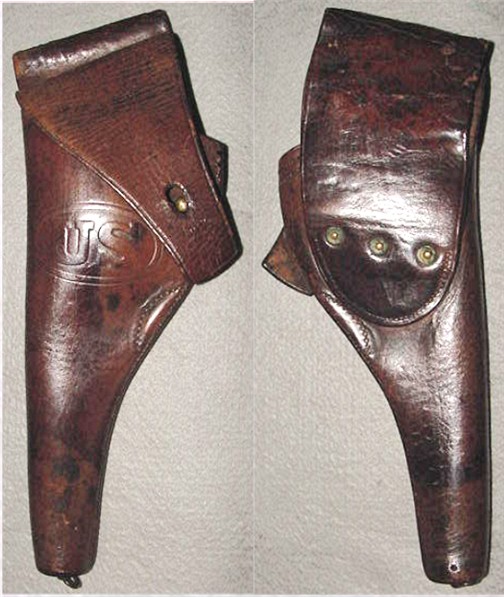 |
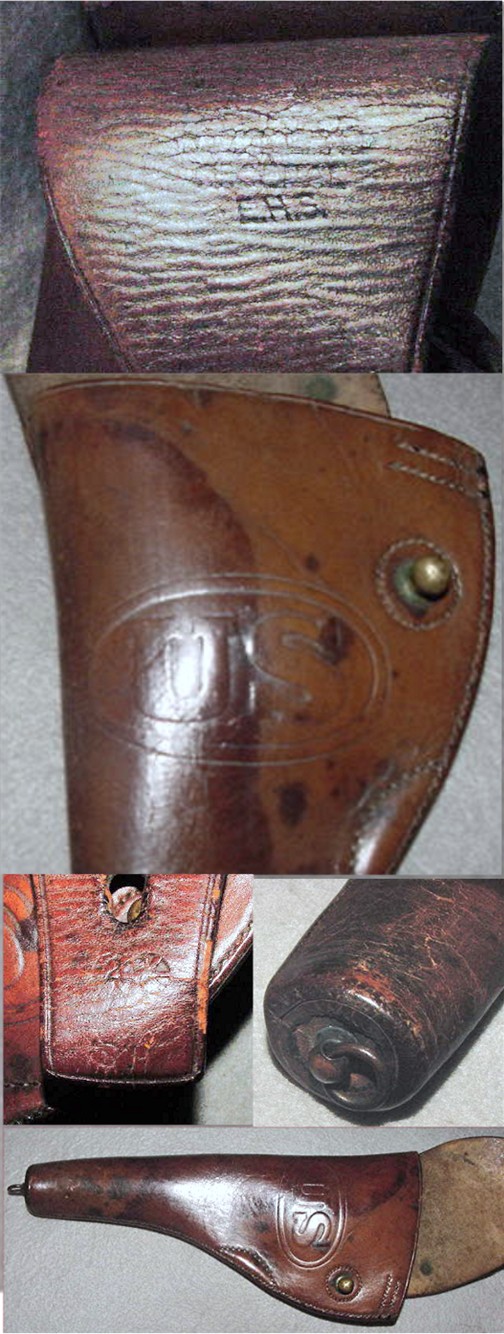 |
|
NO. 2
US ARMY RUSSET LEATHER .38 CALIBER DOUBLE-ACTION
ARMY REVOLVER HOLSTER, FOURTH TYPE – DATED 1903 – ROCK
ISLAND ARSENAL: This is a specimen from the
first year of production of the “russet leather”
holsters, identified by the “ROCK ISLAND ARSENAL” stamp
and production date “1903” applied to the reverse of the
holster belt loop.
An excellent specimen, this attractive holster has
survived in very respectable condition, with solid
stitching, all of the seams intact, and all of the
components, to include the plug and tie down ring, are
present. The body is solid and full form with no weak
points. The embossed “US” in the oval on the front of
the holster body is legible. The “Rock Island Arsenal”
maker’s stamp, the date, and the inspector’s initials “H.E.K.”
on the belt loop is fully legible. The flap is also
stamped with the piece worker’s initials at the end of
the flap below the closing finial hole. The leather
surface on the body and the flap is overall very smooth
and bright, retaining a light caramel color with no
crazing or flaking.
This is a very nice specimen from the first year of
production russet leather holsters, and one which would
be very difficult to upgrade. (0207) $295 |
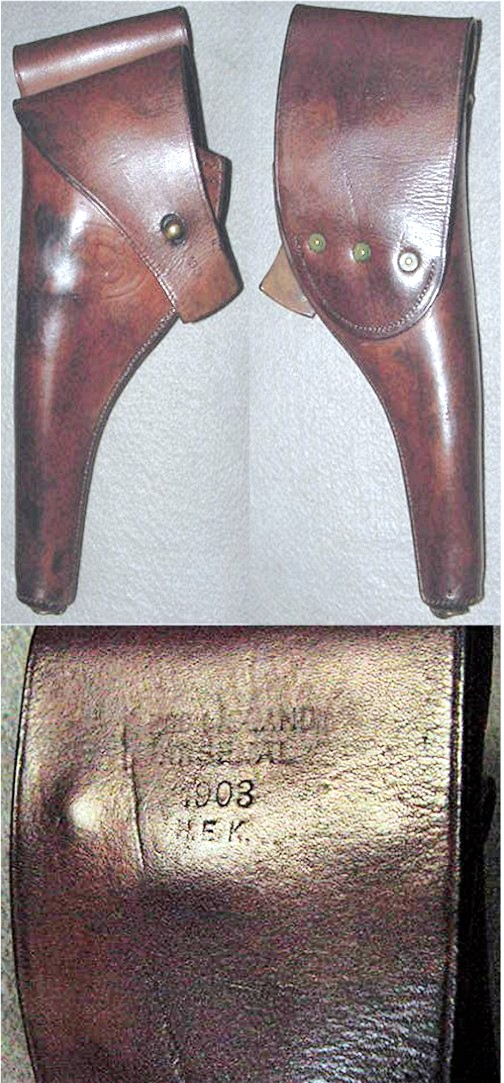 |
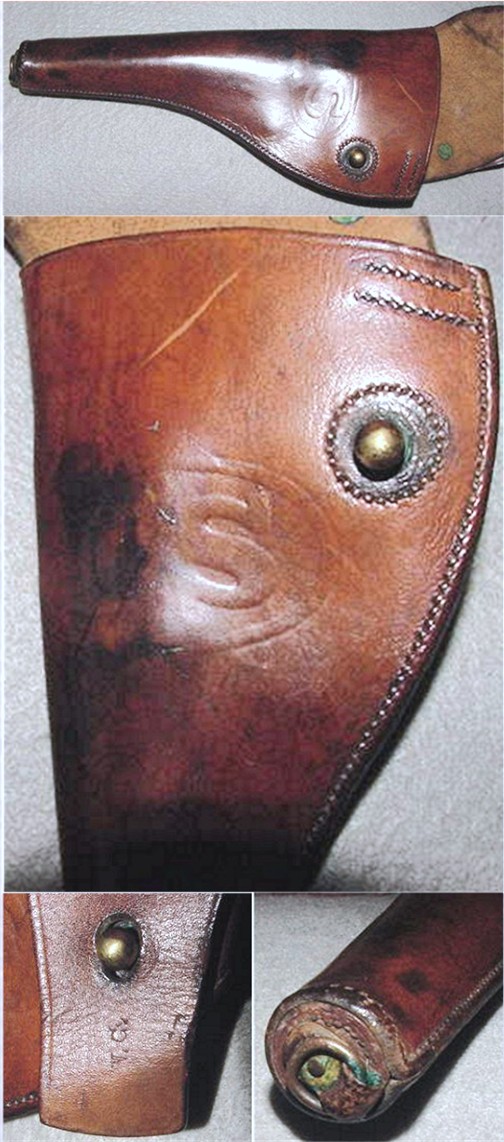 |
|
NO. 3
US ARMY RUSSET LEATHER .38 CALIBER
DOUBLE-ACTION ARMY REVOLVER HOLSTER, FOURTH TYPE – DATED
1904 – ROCK ISLAND ARSENAL: This is a specimen
from the second year of production of the “russet
leather” holsters, identified by the “ROCK ISLAND
ARSENAL” stamp and production date “1904” applied to the
reverse of the holster belt loop.
An excellent specimen, this attractive holster has
survived in very respectable condition, with solid
stitching, all of the seams intact, and all of the
components, to include the plug and tie down ring, are
present. The body is solid and full form with no weak
points. The embossed “US” in the oval on the front of
the holster body is legible. The “Rock Island Arsenal”
maker’s stamp, the date, and the inspector’s initials
“T.C.” on the belt loop is fully legible. The flap is
also stamped with the piece worker’s initials at the end
of the flap below the closing finial hole. The leather
surface on the body and the flap is overall very smooth
and bright, retaining a notably light caramel color with
no crazing or flaking. The original full length elk
hide tie down thong is also present, a definite added
value.
This is a very nice specimen from the second year of
production russet leather holsters, and one which would
be very difficult to upgrade.
SOLD |
 |
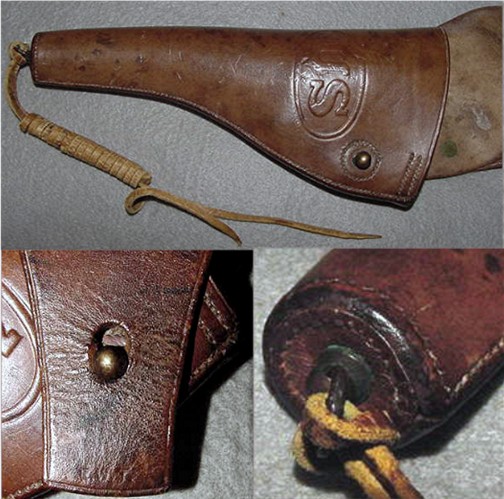 |
|
NO. 4
US ARMY RUSSET LEATHER .38 CALIBER
DOUBLE-ACTION ARMY REVOLVER HOLSTER, FIFTH TYPE – DATED
1909 – ROCK ISLAND ARSENAL: The last
pattern of this series, this holster featured a more
pronounced curve in the body of the holster. This
specimen from the third year of production of these
Fifth Type holsters, identified by the four line “ROCK
ISLAND ARSENAL” stamp and production date “1909” applied
to the reverse of the holster belt loop.
An excellent specimen, this attractive holster presents
in "like new" unissued condition. The deep
mahogany color results from the original arsenal applied
"stuffed russet leather" finish, resulting from
saturating, or "stuffing" the leather with oil in order
to soften and preserve it. The arsenal method did
not result in weakened leather which would not keep its
shape and was softened to the point of tearing such as
is experienced with many home remedy leather treatments
used through the years. Rather, those
accoutrements which have retained the stuffed leather
finish have survived in the excellent condition which
this holster displays. The down side of stuffed
leather was that due to the amount of oil, in use it was
prone to stain the soldiers' uniforms. To combat
this staining, the troops were directed to soak the
accoutrements in naphtha and other treatments which
leeched out the oil, and in turn made the leather more
susceptible to aging and wear. How or why this
holster escaped the naphtha treatment is anyone's guess,
but that it did provides an nearly pristine example of
what these holsters looked like when newly manufactured
and issued.
In keeping with not having been issued, the holster has
survived with solid
stitching, all of the seams intact, and all of the
components, to include the plug and tie down ring, present
and intact. The body is solid and full form with no weak
points. The embossed “US” in the oval on the front of
the holster body is very distinct. The “Rock Island Arsenal”
maker’s stamp, the date, and the inspector’s initials
“T.C.C.” on the belt loop is fully legible and all the
characters are distinct. The leather surface on
the body and the flap is overall very smooth and bright,
retaining an even color with no crazing or flaking.
The original full length elk hide tie down thong and the
elk hide belt loop thong are both present - a definite added
value.
This is an excellent specimen of the last pattern of
these russet leather holsters, and one which would be
very difficult to upgrade.
SOLD
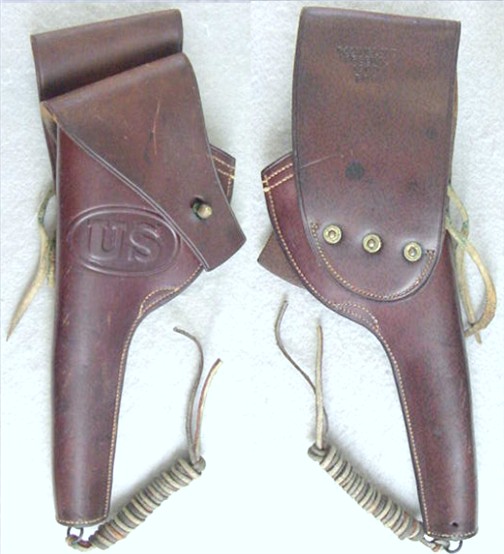 |
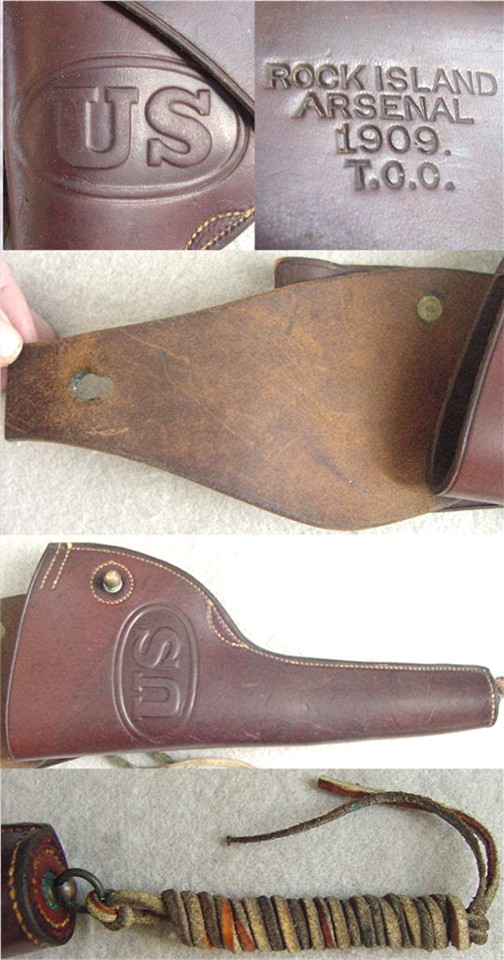 |
|
|
|
|
|
|
|
|
|
|
|
|

